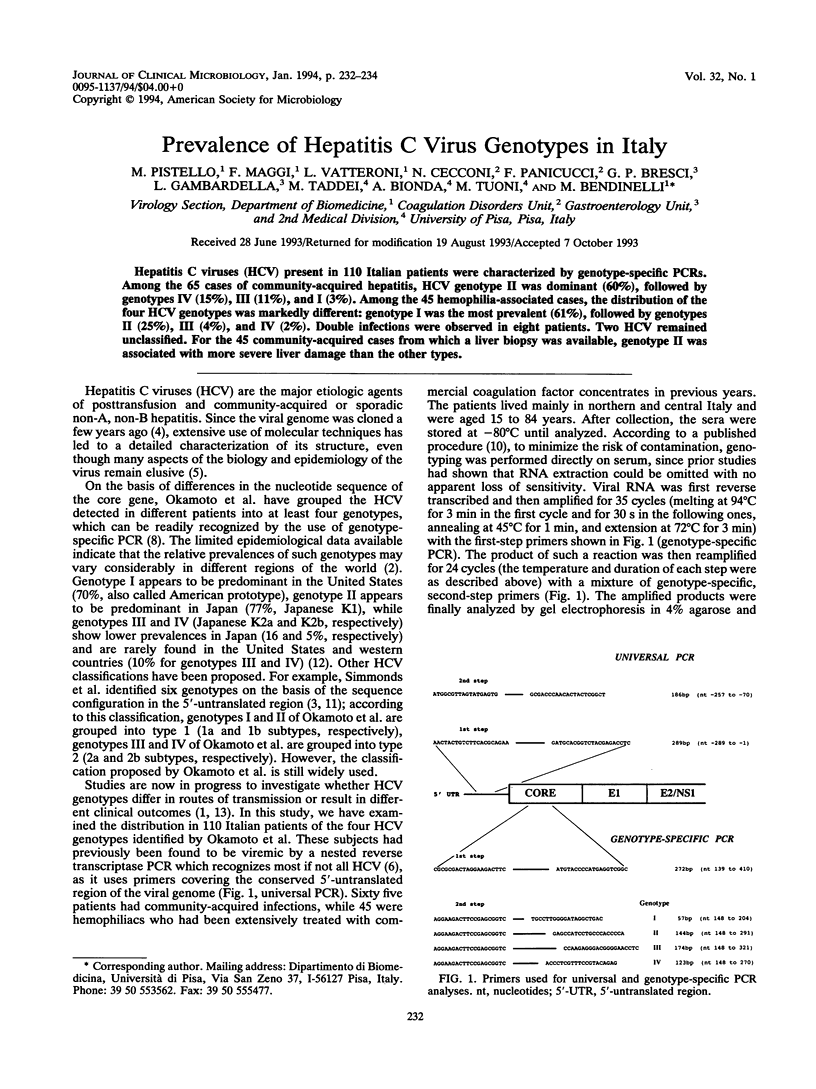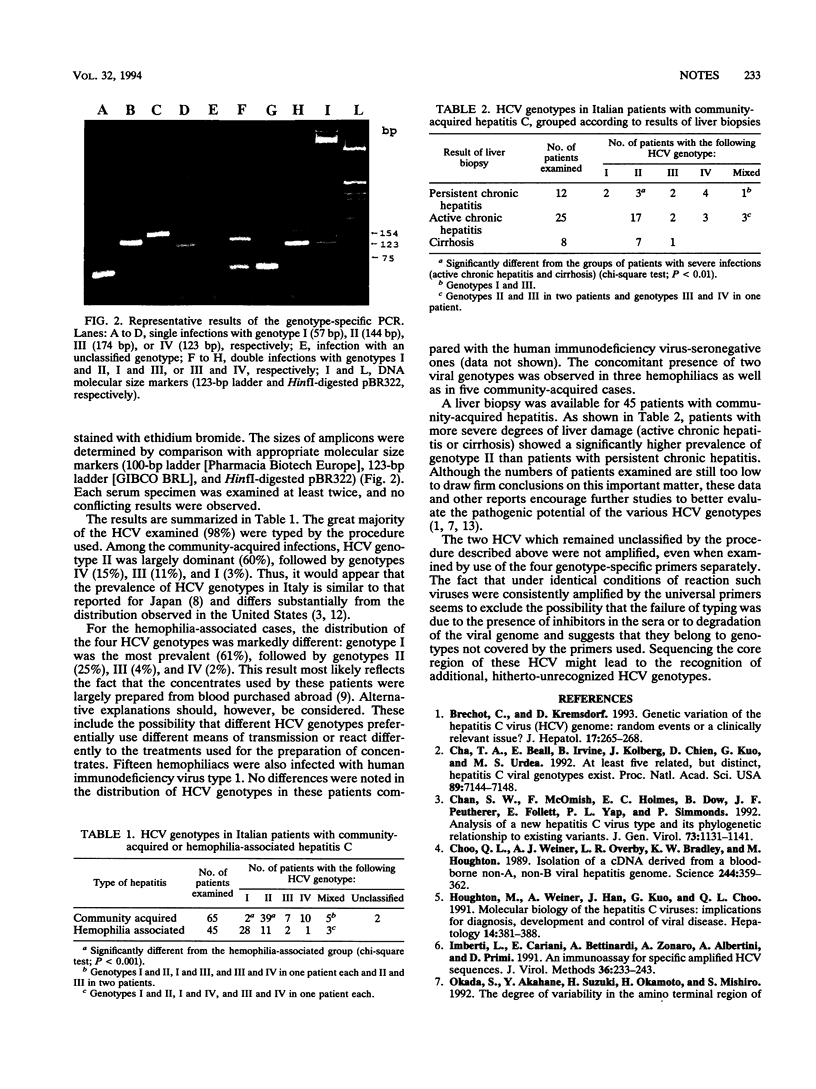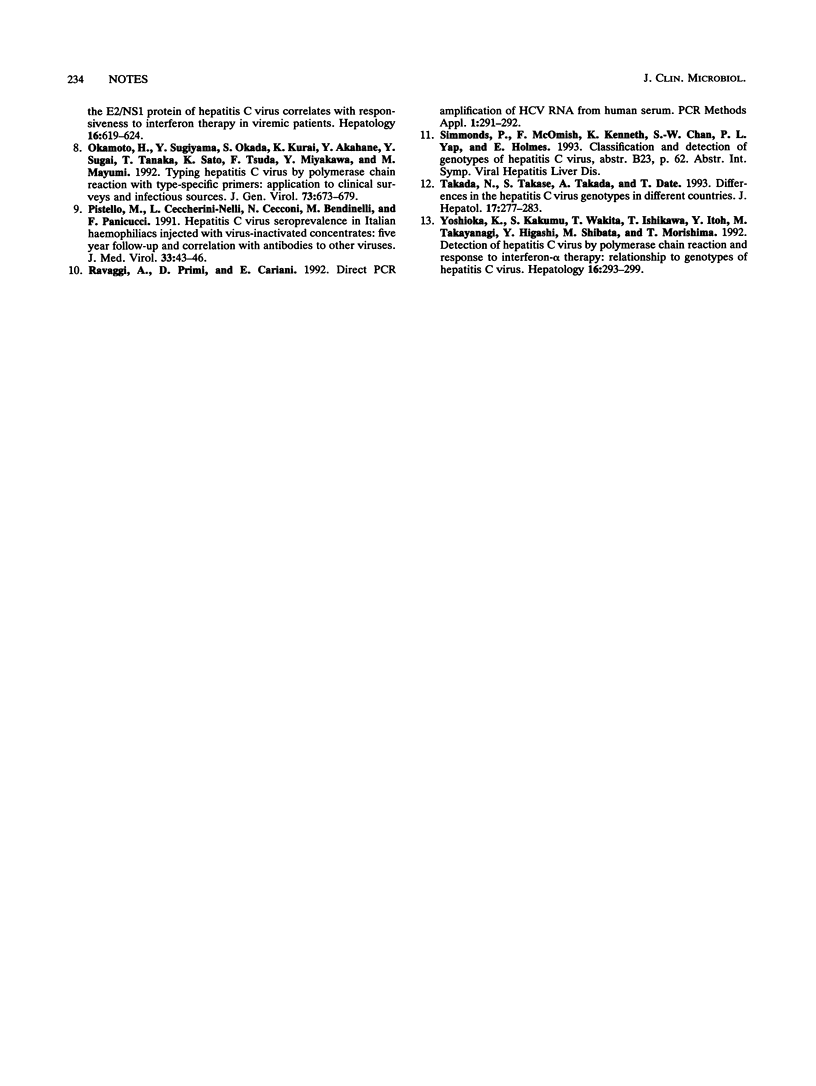Abstract
Hepatitis C viruses (HCV) present in 110 Italian patients were characterized by genotype-specific PCRs. Among the 65 cases of community-acquired hepatitis, HCV genotype II was dominant (60%), followed by genotypes IV (15%), III (11%), and I (3%). Among the 45 hemophilia-associated cases, the distribution of the four HCV genotypes was markedly different: genotype I was the most prevalent (61%), followed by genotypes II (25%), III (4%), and IV (2%). Double infections were observed in eight patients. Two HCV remained unclassified. For the 45 community-acquired cases from which a liver biopsy was available, genotype II was associated with more severe liver damage than the other types.
Full text
PDF


Images in this article
Selected References
These references are in PubMed. This may not be the complete list of references from this article.
- Bréchot C., Kremsdorf D. Genetic variation of the hepatitis C virus (HCV) genome: random events or a clinically relevant issue? J Hepatol. 1993 Mar;17(3):265–268. doi: 10.1016/s0168-8278(05)80203-x. [DOI] [PubMed] [Google Scholar]
- Cha T. A., Beall E., Irvine B., Kolberg J., Chien D., Kuo G., Urdea M. S. At least five related, but distinct, hepatitis C viral genotypes exist. Proc Natl Acad Sci U S A. 1992 Aug 1;89(15):7144–7148. doi: 10.1073/pnas.89.15.7144. [DOI] [PMC free article] [PubMed] [Google Scholar]
- Chan S. W., McOmish F., Holmes E. C., Dow B., Peutherer J. F., Follett E., Yap P. L., Simmonds P. Analysis of a new hepatitis C virus type and its phylogenetic relationship to existing variants. J Gen Virol. 1992 May;73(Pt 5):1131–1141. doi: 10.1099/0022-1317-73-5-1131. [DOI] [PubMed] [Google Scholar]
- Choo Q. L., Kuo G., Weiner A. J., Overby L. R., Bradley D. W., Houghton M. Isolation of a cDNA clone derived from a blood-borne non-A, non-B viral hepatitis genome. Science. 1989 Apr 21;244(4902):359–362. doi: 10.1126/science.2523562. [DOI] [PubMed] [Google Scholar]
- Houghton M., Weiner A., Han J., Kuo G., Choo Q. L. Molecular biology of the hepatitis C viruses: implications for diagnosis, development and control of viral disease. Hepatology. 1991 Aug;14(2):381–388. [PubMed] [Google Scholar]
- Imberti L., Cariani E., Bettinardi A., Zonaro A., Albertini A., Primi D. An immunoassay for specific amplified HCV sequences. J Virol Methods. 1991 Oct;34(3):233–243. doi: 10.1016/0166-0934(91)90103-7. [DOI] [PubMed] [Google Scholar]
- Okamoto H., Sugiyama Y., Okada S., Kurai K., Akahane Y., Sugai Y., Tanaka T., Sato K., Tsuda F., Miyakawa Y. Typing hepatitis C virus by polymerase chain reaction with type-specific primers: application to clinical surveys and tracing infectious sources. J Gen Virol. 1992 Mar;73(Pt 3):673–679. doi: 10.1099/0022-1317-73-3-673. [DOI] [PubMed] [Google Scholar]
- Pistello M., Ceccherini-Nelli L., Cecconi N., Bendinelli M., Panicucci F. Hepatitis C virus seroprevalence in Italian haemophiliacs injected with virus-inactivated concentrates: five year follow-up and correlation with antibodies to other viruses. J Med Virol. 1991 Jan;33(1):43–46. doi: 10.1002/jmv.1890330109. [DOI] [PubMed] [Google Scholar]
- Ravaggi A., Primi D., Cariani E. Direct PCR amplification of HCV RNA from human serum. PCR Methods Appl. 1992 May;1(4):291–292. doi: 10.1101/gr.1.4.291. [DOI] [PubMed] [Google Scholar]
- Takada N., Takase S., Takada A., Date T. Differences in the hepatitis C virus genotypes in different countries. J Hepatol. 1993 Mar;17(3):277–283. doi: 10.1016/s0168-8278(05)80205-3. [DOI] [PubMed] [Google Scholar]
- Yoshioka K., Kakumu S., Wakita T., Ishikawa T., Itoh Y., Takayanagi M., Higashi Y., Shibata M., Morishima T. Detection of hepatitis C virus by polymerase chain reaction and response to interferon-alpha therapy: relationship to genotypes of hepatitis C virus. Hepatology. 1992 Aug;16(2):293–299. doi: 10.1002/hep.1840160203. [DOI] [PubMed] [Google Scholar]



